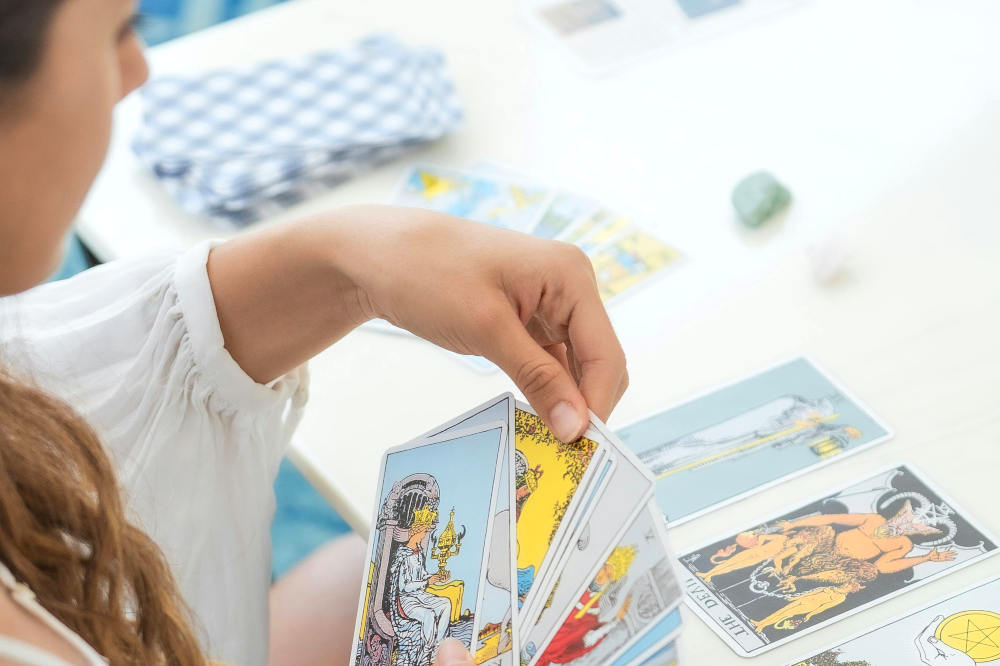
Les cartes de tarot fascinent depuis des siècles. Avec leurs symboles mystérieux, leurs illustrations évocatrices et leurs liens avec l'occulte, elles ont souvent été perçues avec suspicion. Certains les voient comme des outils de découverte de soi et d'orientation, tandis que d'autres les associent au danger, à la superstition, voire au mal. Alors, les cartes de tarot sont-elles dangereuses à utiliser ? La réponse dépend de la façon dont on les utilise, de ses croyances et du contexte dans lequel on les pratique. Cet article explore les dangers perçus – psychologiques, spirituels et sociaux – ainsi que les bienfaits, les mythes et les pratiques sûres qui entourent le tarot.
Panaprium est indépendant et pris en charge par les lecteurs. Si vous achetez quelque chose via notre lien, nous pouvons gagner une commission. Si vous le pouvez, veuillez nous soutenir sur une base mensuelle. La mise en place prend moins d'une minute et vous aurez un impact important chaque mois. Merci!
Que sont les cartes de tarot ?
Le tarot est un jeu de 78 cartes utilisé pour la divination, la méditation et l'introspection. Il est divisé en deux parties :
-
Arcanes majeurs (22 cartes) : Représentent des événements ou des thèmes majeurs de la vie (par exemple, Le Fou, La Mort, Les Amants).
-
Arcanes mineurs (56 cartes) : Similaire à un jeu standard avec quatre couleurs (Coupes, Pentacles, Épées, Bâtons), se concentrant sur les questions quotidiennes.
Bien que les origines exactes du tarot soient controversées, les historiens s'accordent généralement à dire qu'il s'agissait d'un jeu de cartes né en Europe au XVe siècle. Ce n'est qu'au XVIIIe siècle que le tarot a été associé au mysticisme et à la voyance.
Craintes courantes concernant les cartes de tarot
Les cartes de tarot suscitent souvent peur et stigmatisation, surtout dans les milieux conservateurs ou religieux. Ces craintes se répartissent généralement en trois catégories :
1. Danger spirituel
Certains croient que les cartes de tarot ouvrent des portes vers des forces obscures ou des entités démoniaques. Cette inquiétude est particulièrement répandue dans les communautés chrétiennes, où la divination est souvent qualifiée de péché ou de satanique. Des passages de la Bible, comme Deutéronome 18:10-12, mettent en garde contre la divination et la « consultation des esprits », ce qui conduit beaucoup à considérer le tarot comme spirituellement dangereux.
Cependant, tous les praticiens ne considèrent pas le tarot comme un outil spirituel au sens surnaturel. Beaucoup le voient comme un miroir psychologique plutôt que comme un moyen de contacter les esprits. Il n'existe aucune preuve scientifique que les cartes de tarot invoquent des entités ou accèdent à des royaumes surnaturels, sauf si l'on est prédisposé à le croire.
2. Dommage psychologique
Une inquiétude plus fondée est que le tarot peut engendrer de l'anxiété, des obsessions ou des illusions. Certains utilisateurs deviennent trop dépendants des lectures, les utilisant pour prendre toutes leurs décisions – des relations aux finances – au lieu de réfléchir de manière critique ou de consulter un professionnel.
Une étude de 2019 publiée dans le Journal of Spirituality in Mental Health a révélé que, chez certaines personnes, les pratiques divinatoires comme le tarot peuvent contribuer à accroître l'anxiété si elles ne sont pas contrebalancées par une réflexion rationnelle. Des prophéties autoréalisatrices peuvent se produire si une personne est convaincue d'un résultat négatif.
3. Fraude et manipulation
Certains tarologues exploitent les personnes vulnérables en leur facturant des honoraires élevés ou en faisant des déclarations spectaculaires. Des tactiques comme annoncer à leurs clients qu'ils sont maudits ou leur proposer des « rituels de purification » coûteux sont non seulement contraires à l'éthique, mais peuvent aussi causer des dommages psychologiques et financiers.
Le problème ne vient pas des cartes de tarot elles-mêmes, mais plutôt de praticiens malhonnêtes. Comme dans tout domaine, il existe des professionnels dignes de confiance et des acteurs malhonnêtes.
Existe-t-il des preuves de danger ?
Il n'existe aucune preuve scientifique que les cartes de tarot soient dangereuses. Ce sont des morceaux de papier ornés d'illustrations. Le danger réside dans la manière dont elles sont utilisées et dans le sérieux avec lequel elles sont prises .
L'American Psychological Association ne considère pas le tarot comme intrinsèquement nocif, mais note que tout outil utilisé à la place des soins de santé mentale professionnels peut être problématique, en particulier si une personne est confrontée à un traumatisme, à une psychose ou à une dépression sévère.
Dans de rares cas, les personnes souffrant de certains troubles mentaux peuvent interpréter les messages du tarot de manière néfaste. Par exemple, une personne atteinte de délires paranoïaques peut croire que les cartes l'avertissent de complots ou de dangers. Ce risque n'est pas propre au tarot : il s'applique également aux rêves, aux horoscopes, voire aux textes religieux lorsqu'ils sont interprétés sans ancrage dans la réalité.
Quand le Tarot peut être utile
Beaucoup de gens utilisent le tarot non pas comme un oracle surnaturel, mais comme un outil d' introspection , de réflexion personnelle et de pensée créative . En voici quelques exemples :
1. Usage thérapeutique
Certains thérapeutes intègrent le tarot à leurs séances pour aider leurs clients à explorer leurs pensées inconscientes, leurs archétypes ou leurs récits personnels. Connue sous le nom de thérapie par le tarot , cette pratique utilise la nature symbolique des cartes pour susciter la discussion, à la manière du test des taches d'encre de Rorschach.
Une étude de 2021 publiée dans le Journal of Humanistic Psychology a révélé que des outils symboliques comme le tarot peuvent améliorer la thérapie narrative en aidant les clients à exprimer leurs émotions de manière non menaçante et métaphorique.
2. Inspiration créative
Les écrivains, artistes et musiciens utilisent souvent les cartes de tarot pour stimuler leurs idées. Tirer des cartes comme « La Tour » ou « L'Impératrice » peut inspirer des personnages, des thèmes ou des images. Le caractère aléatoire et le symbolisme du tarot encouragent à sortir des sentiers battus.
3. Prise de décision et réflexion
Le tarot peut aider à clarifier les sentiments face à une situation en offrant de nouvelles perspectives. Il ne prédit pas l'avenir avec certitude, mais peut mettre en lumière des schémas ou des options que l'on n'aurait peut-être pas envisagés. Ce processus peut être stimulant plutôt que déterministe.
Mythes sur les cartes de tarot
Examinons et démystifions quelques mythes courants qui contribuent à l’idée que le tarot est dangereux.
Mythe n°1 : Les cartes de tarot peuvent vous maudire.
Rien ne prouve que les cartes de tarot aient le pouvoir intrinsèque de vous maudire ou de vous nuire. Ce sont des outils, comme des miroirs ou des journaux intimes. Si quelqu'un se sent maudit après une lecture, c'est probablement dû à une suggestion ou à l'anxiété, et non aux cartes elles-mêmes.
Mythe n°2 : Vous ne devriez jamais acheter votre propre jeu de tarot.
Il s'agit d'une superstition, et non d'un fait. De nombreux lecteurs expérimentés achètent leurs propres jeux et ressentent un lien profond avec eux. L'idée qu'un jeu doive être offert en cadeau n'a aucune incidence sur sa sécurité ou son efficacité.
Mythe n°3 : Le Tarot prédit toujours l’avenir.
Le tarot n'est pas une boule de cristal. Si certains pensent qu'il peut offrir un aperçu des résultats potentiels, la plupart des lecteurs modernes privilégient les possibilités , le libre arbitre et l'action personnelle . Une lecture reflète votre énergie actuelle, et non un destin figé.
Mythe n°4 : Il faut être médium pour lire le tarot.
Tout le monde peut apprendre à lire le tarot. Si certains lecteurs revendiquent des capacités intuitives ou psychiques, la plupart s'appuient sur le symbolisme, la psychologie et la narration. Le « danger » souvent associé au tarot survient lorsque les gens accordent une confiance aveugle à de prétendues figures d'autorité psychique, sans esprit critique.
Pratiques sûres pour l'utilisation du Tarot
Pour minimiser les dangers potentiels et maximiser les avantages, tenez compte de ces bonnes pratiques :
1. Gardez les pieds sur terre
N'oubliez pas que le tarot est un outil, et non une solution magique aux problèmes de la vie. Utilisez-le pour réfléchir, et non pour prendre des décisions rigides. Si vous êtes confronté à de graves difficultés, consultez des professionnels compétents.
2. Évitez la surutilisation
Faire trop de lectures en peu de temps peut engendrer confusion ou obsession. Laissez libre cours à votre intuition et à votre expérience quotidienne pour vous guider.
3. Soyez attentif à la santé mentale
Si vous vous sentez anxieux, paranoïaque ou déprimé, le tarot n'est peut-être pas la solution. Évitez d'interpréter les cartes comme des prédictions ou des avertissements littéraux.
4. Examinez attentivement les lecteurs vétérinaires
Si vous demandez une consultation à quelqu'un d'autre, renseignez-vous d'abord sur lui. Évitez toute personne qui fait des déclarations excessives, facture des honoraires élevés ou tente de vous faire peur pour vous inciter à revenir.
5. Définissez des intentions claires
Avant de faire une consultation, demandez-vous : qu’est-ce que j’espère explorer ou comprendre ? Des questions claires mènent à des idées plus claires.
Que disent les différents systèmes de croyances ?
christianisme
De nombreux chrétiens considèrent le tarot comme une forme de divination condamnée par la Bible. Cependant, tous les chrétiens n'interprètent pas les Écritures de la même manière. Certains théologiens libéraux voient le tarot comme une forme de narration ou de dialogue intérieur plutôt que comme de l'occultisme.
Croyances New Age et païennes
De nombreux adeptes du New Age et du paganisme considèrent le tarot comme un outil spirituel les reliant à la sagesse intérieure, aux divinités ou à l'énergie universelle. Dans ces communautés, le tarot n'est pas perçu comme dangereux, mais comme sacré et porteur de sens.
Points de vue sceptiques et laïcs
Les sceptiques considèrent souvent le tarot comme une pseudoscience ou un divertissement. Pourtant, nombreux sont ceux qui reconnaissent sa valeur psychologique lorsqu'il est utilisé métaphoriquement. Tant que les utilisateurs sont conscients que les cartes sont symboliques et non magiques, le risque est faible.
Conclusion : les cartes de tarot sont-elles dangereuses ?
Les cartes de tarot ne sont pas intrinsèquement dangereuses. Ce sont des outils symboliques et, comme tout outil, leur impact dépend de la manière dont on les utilise et de l'interprétation qu'on en fait. Bien qu'il existe des risques, surtout en cas d'utilisation obsessionnelle, manipulatrice ou en remplacement d'une aide professionnelle, elles présentent également des avantages significatifs lorsqu'elles sont abordées avec intention et pondération.
La clé réside dans l'esprit critique. Si vous abordez le tarot avec curiosité, respect et conscience de soi, il peut devenir un puissant outil de réflexion et de développement, et non une source de peur.
Cet article vous a-t-il été utile ? S'il vous plaît dites-nous ce que vous avez aimé ou n'avez pas aimé dans les commentaires ci-dessous.
About the Author: Alex Assoune
Contre Quoi Nous Luttons
Les groupes multinationaux surproduisent des produits bon marché dans les pays les plus pauvres.
Des usines de production où les conditions s’apparentent à celles d’ateliers clandestins et qui sous-payent les travailleurs.
Des conglomérats médiatiques faisant la promotion de produits non éthiques et non durables.
De mauvais acteurs encourageant la surconsommation par un comportement inconscient.
- - - -
Heureusement, nous avons nos supporters, dont vous.
Panaprium est financé par des lecteurs comme vous qui souhaitent nous rejoindre dans notre mission visant à rendre le monde entièrement respectueux de l'environnement.
Si vous le pouvez, veuillez nous soutenir sur une base mensuelle. Cela prend moins d'une minute et vous aurez un impact important chaque mois. Merci.































0 commentaire